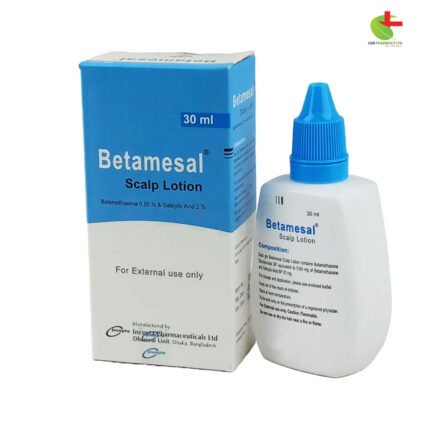Nyclobate Lotion
200.00৳ Bottle (60ml)
- Nyclobate is a potent topical corticosteroid cream, ointment, shampoo, and spray containing Clobetasol Propionate BP 0.05%.
- It is effective in treating conditions like psoriasis (excluding widespread plaque psoriasis), recalcitrant dermatoses, lichen planus, and discoid lupus erythematosus.
- The product has anti-inflammatory, antipruritic, and vasoconstrictive properties, suitable for both adults and children over one year.
- Recommended for short-term use to avoid side effects, especially on sensitive areas and in children.
 Brand
Brand
|
Incepta Pharmaceuticals Ltd |
|---|---|
 Generics
Generics
|
Clobetasol Propionate |
 Type
Type
|
Lotion |
Indications
Nyclobate is prescribed for adults, the elderly, and children over the age of 1 for various skin conditions, including:
- Psoriasis (excluding widespread plaque psoriasis)
- Stubborn dermatoses
- Lichen planus
- Discoid lupus erythematosus
- Other skin conditions that haven’t responded well to milder steroids
Use this medication only as directed by a licensed healthcare provider.
Composition
- Clobetasol Propionate Cream: Contains 0.5 mg of Clobetasol Propionate BP (0.05% w/w) per gram.
- Clobetasol Propionate Ointment: Contains 0.5 mg of Clobetasol Propionate BP (0.05% w/w) per gram.
- Clobetasol Propionate Scalp Application: Contains 0.5 mg of Clobetasol Propionate BP (0.05% w/w) per gram.
- Clobetasol Propionate Shampoo: Contains 0.5 mg of Clobetasol Propionate BP (0.05% w/w) per gram.
- Clobetasol Propionate Lotion: Contains 0.5 mg of Clobetasol Propionate BP (0.05% w/w) per gram.
- Clobetasol Propionate Spray: Contains 0.5 mg of Clobetasol Propionate BP (0.05% w/w) per gram.
Pharmacology
Clobetasol Propionate is a high-potency topical corticosteroid with anti-inflammatory, anti-itching, and blood vessel-constricting properties. Its anti-inflammatory action works through various mechanisms to reduce late-phase allergic reactions by lowering mast cell density, suppressing eosinophil activity, and reducing cytokine production, along with inhibiting arachidonic acid metabolism.
Dosage
- Cream and Ointment: For adults, elderly, and children over 1 year, apply a thin layer to affected skin areas twice daily. Repeated short courses may be used to manage flare-ups. In resistant cases, especially with hyperkeratosis, covering the treatment area with plastic film overnight may enhance effectiveness. Use should be limited to two consecutive weeks, and weekly doses should not exceed 50 g. In children, limit courses to five days with weekly review.
- Spray: Apply as needed to affected scalp areas once or twice daily, not exceeding 50 ml weekly. Massage in gently if necessary. Discontinue if no improvement is observed within a week, or when lesions heal.
- Shampoo: Apply to a dry scalp, massaging gently into the affected areas once daily. Leave on for 15 minutes before rinsing. Limit treatment to 4 weeks, not exceeding 50 g per week. Not recommended for those under 18.
- Scalp Solution: Use as needed on affected scalp areas once or twice daily, ensuring the weekly dose does not exceed 50 ml. Massage with fingertips if necessary. Discontinue if no response is observed after one week or when the lesion heals.
Use this medication only as directed by a licensed healthcare provider.
Administration
- Route: Cutaneous. Creams are ideal for moist or oozing skin areas, while ointments suit dry, scaly, or thickened lesions.
Use this medication only as directed by a licensed healthcare provider.
Drug Interactions
Medications that inhibit CYP3A4 enzymes (such as ritonavir and itraconazole) may slow corticosteroid metabolism, potentially increasing systemic exposure.
Contraindications
Do not use Clobetasol Propionate in cases of:
- Rosacea, acne, and perioral dermatitis
- Primary viral infections like herpes simplex or chickenpox
- Hypersensitivity to the medication
- Fungal (e.g., candidiasis) or bacterial infections (e.g., impetigo) as the primary issue
- Genital and perianal itching
- Skin conditions in children under one year, including dermatitis and diaper rash
Side Effects
Excessive or long-term use of potent corticosteroids over large areas can lead to systemic effects, including hypercorticism. Prolonged or intensive application may also cause skin thinning, stretch marks, and visible blood vessel dilation. In rare cases, psoriasis treatment with corticosteroids (or their discontinuation) may lead to pustular psoriasis. Other side effects include pigmentation changes and increased hair growth.
Pregnancy and Lactation
Limited data is available on Clobetasol Propionate use during pregnancy. Animal studies have shown that topical corticosteroids can cause fetal abnormalities, though relevance to human pregnancy is uncertain. This cream should only be used during pregnancy and lactation if the benefits justify potential risks. The drug’s presence in breast milk is unknown, so caution is advised for nursing mothers.
Precautions and Warnings
Avoid prolonged use, especially in children and infants, due to risk of adrenal suppression. Limit facial applications to brief periods due to potential skin thinning. Care is required when applying near the eyes to prevent possible glaucoma or cataract formation.
For patients with psoriasis, close monitoring is advised due to risks of rebound, tolerance, and systemic toxicity. If infected, discontinue topical corticosteroid treatment and initiate appropriate antimicrobial therapy. Bacterial infection may occur with occlusive dressings, so cleanse skin before reapplying.
Use in Special Populations
In children under 12, limit long-term topical corticosteroid use to avoid adrenal suppression. Children are more susceptible to skin thinning and other side effects from these treatments.
Overdose Effects
Acute overdose is unlikely, but chronic misuse may lead to symptoms of hypercortisolism, in which case the steroid should be discontinued.
Therapeutic Class
Other topical corticosteroids.
Storage Conditions
Store below 30°C, protected from light and moisture. Do not freeze. Keep out of reach of children.













Reviews
There are no reviews yet.